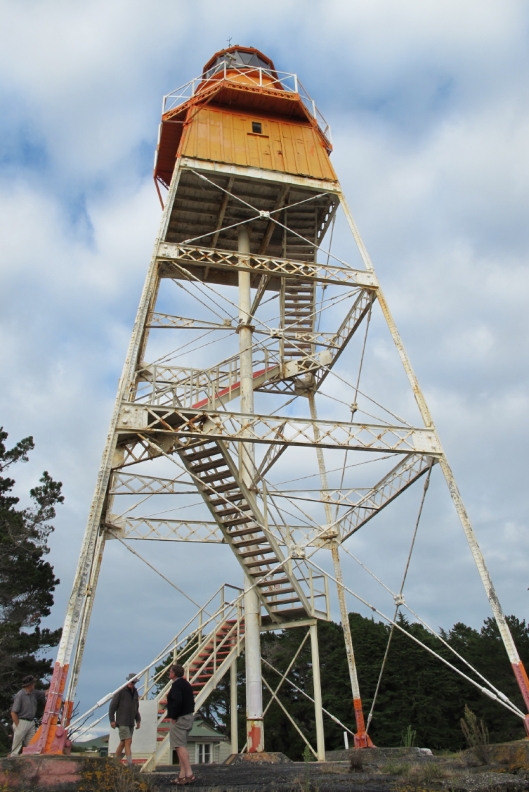Tags
"A Walk a Day", Cape Farewell, Farewell Spit, Farewell Spit Eco-Tours, Gannets, Geology, Oyster-catchers, Whale stranding

Whale skeleton outside one of the Keeper’s Cottages – with a signpost that clearly did the whale no good.
News of more pilot whale strandings has my mind going back to last summer and Farewell Spit. Such a place of drama and expanse. Such a deadly attraction for whales. A Walk a Day – a newly published book by Peter Janssen – retells the Maori legend of why. “Kuku (mussels) and pipi fought for supremacy of the sandy beach. The pipi won, driving the mussels onto the rocks. The noisy fight drew the attention of Takaako (a shark) and Te Pu (a whale). While the fight held no interest, the victorious pipi with their large tasty tongues were excellent food. Te Pu and Takaako rushed the pipi, which quickly pulled their heads into the sand, and the great sea-creatures ended up stranded with their mouths full of sand.”
Last summer, we finally (but not fatally) answered the long-felt pull of the Spit.
In a holiday of clear blue skies, we booked for a trip on a day when the heavens fell. A hasty postponement had us going out early in the morning of the next day – the tide dictates the tour timetable – and the reward for the 5am wake-up and dark stumble from house-bus Feierabend to tour-bus Maryann was being on the Spit as night changed to day, and rain to shine.
There are places where moody light feels right: this is one.

Black Oyster-catchers. Tour Guide factoid: If you see more than two together, the “extras” are chicks. Pairs maintain a strict 500m territorial separation. Their Pied cousins are more gregarious.
While you can drive out and do a short walk round the base of the Spit, going any further requires serious transport, with a Doc-approved company.
That’s worth it – not just for the access – but also for the commentary.
OK – I’m a self-confessed info-junky. I hover round tour-guides, I merge into parties with an English-speaking guide and try to look as if I’m a bonafide member of the group, I’m that annoying person who asks a question just when the rest of the group is ready to move on… but…
There’s such a joy in hearing someone who really knows their stuff talking about it. Our guide guy was one such. He knew his geology, his ornithology, his history… and he had that Kiwi-guide dryly humorous delivery that you don’t seem to get anywhere else in the world.
So now we know…
Farewell Spit is, at low tide, the second largest sand-plain in the world (Poland currently holds the record). But our Spit is aspiring… with what’s calculated as 4 million cubic metres of sand joining the effort each year, and working on stretching across Golden Bay. They say earlier versions of the sandspit reached right up towards Wanganui, so it has a template!
Farewell Spit’s Maori name is Onetahua – meaning “heaped up sand”. Cook perhaps didn’t know that when he renamed it from his own perspective. The sand starts as rocks in the Alps, emerges on the West Coast, is ground down, carried up by the tides sweeping north-east, and deposited in that great sweeping arc of sand.
As nature has it, Farewell Spit is totally sand. So, an early lighthouse keeper brought in soil by the saddle-bag load to plant sheltering macrocarpas and pines.
These turned out to be, at least by day, as good a marker as the lighthouse itself. There’s been a lighthouse here since 1870, with the current construction standing since 1897. It needed to be steel; the original in hardwood was worn all-but worn away by wind and sand in under 30 years!
Of course, the birds don’t need such navigation aids: they flock here from the other end of the earth, through their own GPS programming. It’s the ideal destination: remote, full of fine dining, your choice of wild ocean-side or calm bay-side bathing, a declared sanctuary, and strictly limited and controlled numbers of intruders. What more could you ask? 112 species of birds can’t be wrong!

Permanent residents – the South Island’s largest land-based gannet colony. The colony started only in 1983 with about 70 pairs of birds – now there may be 3000 colonists.
 So – out we drove, with the odd seal hardly bothering to stir itself – along the ocean side of the spit to beyond the lighthouse, then back into the shelter of the old trees and the once-were-keepers’ cottages that now act as visitors’ centres for morning tea, then back along the outer spit to be off before the tide came in, and stranded us!
So – out we drove, with the odd seal hardly bothering to stir itself – along the ocean side of the spit to beyond the lighthouse, then back into the shelter of the old trees and the once-were-keepers’ cottages that now act as visitors’ centres for morning tea, then back along the outer spit to be off before the tide came in, and stranded us!
Our bus-load was that great mix of Kiwi visitors and world-travellers: somehow seeing things in company with other people’s eyes adds perspectives. There’s also that borrowed pride, that such a place, with such a history, and now, such dedicated care for its continued preservation, is ours.
And then – a reminder that there was a world long before there was anything that was “ours”: a quick trip out to Cape Farewell. The dramatic rock at the northern-most point of the South Island is actually a piece of Gondwanaland river-bank. Now THAT puts us into perspective, which is, I suspect, one of the things that travelling is all about.











